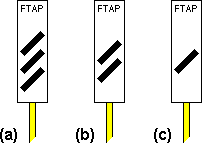|
|
|
|
|
|
|
For a period of a few months during 1990, a notice board with the legend "ATP trials" [29.20] stood beside the Down Main line to the south of Stowe Hill Tunnel (London Midland Region). This board was provided in connection with trials of Automatic Train Protection equipment in the Rugby area. |
|
From 1992, lineside marker boards were installed at Sandite application sites on the Scottish Region. The standard Sandite marker boards (see [29.15 - 29.17]) are not used in Scotland, where alternative white octagonal boards are provided instead. The board marking the commencement of the portion of line over which Sandite requires to be applied bears the abbreviation "sand" [29.21], while the board at the finish point is similar but has a diagonal red stripe superimposed [29.22]. No advance warning boards are provided in conjunction with these signs.
 |
 |
|
[29.21] Commencement of Sandite Application Site.
Area: Scottish Region Usage: Medium Status: Current |
[29.22] Termination of Sandite Application Site.
Area: Scottish Region Usage: Medium Status: Current |
|---|
|
In September 1998, small blue markers [29.23] were installed on the approaches to Theale, Midgham and Thatcham stations (Great Western Zone). These markers were for guidance during braking tests on Class 165 and 166 ('Turbo') trains. |
|
A company called 'LaserThor' developed a system for removing rail head contamination using lasers. A number of trials were conducted, latterly with the laser equipment being mounted on a Multi-Purpose Vehicle (MPV). In the autumn of 2003, trials took place at Oxshott and Wanborough on the Southern Region. Signs were installed at each test site to assist the MPV operator. A sign reading "laser on" [29.24] marked the start of the test site. This was followed by signs lettered "A", "B" and "C" [29.25] at intervals of a quarter mile (0.4 km). The last board in the series, worded "laser off" [29.26], was located one mile (1.6 km) from the start of the test site.
 |
 |
 |
|
[29.24] "Laser On" Sign.
Area: Oxshott / Wanborough Usage: Low Status: Historical |
[29.25] Intermediate Signs.
Area: Oxshott / Wanborough Usage: Low Status: Historical |
[29.26] "Laser Off" Sign.
Area: Oxshott / Wanborough Usage: Low Status: Historical |
|---|
Leaf residue on the rail head can be removed by high-pressure water jetting. On the Scotland Route, octagonal boards were installed from 2006 at the commencement and termination points of locations where water jetting is carried out. The board marking the commencement point bears the words "water jet" [29.27], while the board at the termination point is similar but has a diagonal red stripe superimposed [29.28].
 |
 |
[29.27] Commencement of Water Jetting Site.

Area: Scotland Route Usage: Low Status: Current |
[29.28] Termination of Water Jetting Site.
Area: Scotland Route Usage: Low Status: Current |
|---|
Water jetting sites between Shalford and Reigate on the North Downs Line are marked by five-sided boards with yellow borders. The first board, which has two columns of three diagonal bars [29.29], gives advance warning of a water jetting site. This board is followed by one with two columns of two bars [29.30], marking the point where water jetting should begin. A board with two bars, one above the other [29.31], denotes the point where water jetting should end.
 |
 |
 |
|
[29.29] Advance Warning of Water Jetting Site.
Area: Shalford - Reigate Usage: Low Status: Uncertain |
[29.30] Commencement of Water Jetting Site.
Area: Shalford - Reigate Usage: Low Status: Uncertain |
[29.31] Termination of Water Jetting Site.
Area: Shalford - Reigate Usage: Low Status: Uncertain |
|---|
During the autumn of 2006, marker boards lettered "A", "B" and "C" [29.32 - 29.34] were provided between Ockley and Warnham (Sussex Route) for autumn measurement testing. These signs concerned both the notified MPV treatment train and the Southern test train but with different meanings applying to each. To the treatment train, the "A" marker board [29.32] indicated the point where the notified test specific treatment should be applied. The "B" marker board [29.33] was disregarded by the treatment train, and when the "C" marker board [29.34] was reached, it returned to its usual treatment diagram. For the test train, the "A" marker board [29.32] meant "prepare to conduct brake test". A full service brake application had to be made when the "B" marker board [29.33] was reached. The "C" marker board [29.34] did not apply to the test train.
 |
 |
 |
|
[29.32] "A" Marker Board.
Area: Ockley - Warnham Usage: Low Status: Historical |
[29.33] "B" Marker Board.
Area: Ockley - Warnham Usage: Low Status: Historical |
[29.34] "C" Marker Board.
Area: Ockley - Warnham Usage: Low Status: Historical |
|---|
The High Output train (Track Renewal System) is a mechanised system for carrying out plain-line track renewals. Ordinarily, the train would be required to stop at the preceding controlled signal before moving forward to the work site. From May 2014, a trial aimed at maximising the production time during a single shift was undertaken on the London North Eastern and East Midlands Routes. This entailed the train stopping at the actual site of work, known as the "Flexible Train Arrival Point" (FTAP), before a possession is taken around it. The FTAP stopping point is denoted by a temporary marker at the lineside, which comprises an upright white rectangle with a black roundel in the middle [29.35]. A series of countdown markers with black diagonal bars [29.36] is erected on the approach to the stopping point. The use of Flexible Train Arrival Points came into effect nationally in December 2020.
 |
 |
|
[29.35] FTAP Stopping Point Marker.
Area: LNE and EM Routes (subsequently All Areas) Usage: High Status: Current |
[29.36] FTAP Countdown Markers ( (a) - Outer board; (b) - Intermediate board; (c) - Inner board ).
Area: LNE and EM Routes (subsequently All Areas) Usage: High Status: Current |
|---|
|
|